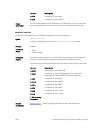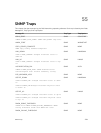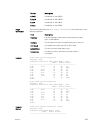
56
Stacking
All commands in this chapter are specific to the Dell Networking operating software.
You can use the commands to pre-configure a switch, so that the configuration settings are invoked
when the switch is attached to other S-Series units.
For information about using the S-Series stacking feature, refer to the “Stacking S-Series Switches”
chapter in the Dell Networking OS Configuration Guide.
CAUTION: You cannot enable stacking simultaneously with virtual link trunking (VLT). If you
enable both at the same time, unexpected behavior occurs.
The Dell Networking OS commands for data center bridging features include 802.1Qbb priority-based
flow control (PFC), 802.1Qaz enhanced transmission selection (ETS), and the data center bridging
exchange (DCBX) protocol.
Switch Stacking and DCB Caveats for the S4820T
The following is a list of behaviors and limitations regarding the use of DCB over S4820T ports involved in
switch stacking:
• You can enable DCB only on 40Gig (QSPF+) ports.
• DCB is not supported over any of the 48 RJ-45 10Gig ports while they are configured in Stacking
mode.
• You cannot configure stacking on any of the 48 RJ-45 10Gig ports if you enable DCB on any of the
40Gig stacking ports.
• If you enable DCB, it disables the ability to use any of the 48 10Gig ports for stacking.
redundancy disable-auto-reboot
Prevent the S-Series stack management unit, stack member unit, and standby unit from rebooting if they
fail.
Syntax redundancy disable-auto-reboot stack-unit [members | 0-11]
To return to the default, use the no redundancy disable-auto-reboot
stack-unit command.
Stacking
1747


















